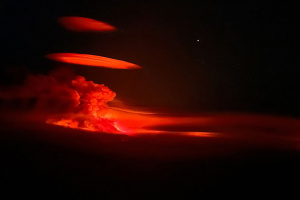Thousands flee wildfires in Canada's far north
General |Author: AFP | August 18, 2023, Friday @ 15:30| 12413 views
This August 16, 2023, high level thermal scan image from the British Columbia Wildfire Service, shows the smoke column from the Lower Adams Lake fire providing more accurate data on actual fire groth and location, approximately 90km (56 miles) northwest of Kamloops, British Columbia. This season, megafires have spread across Canada with remarkable intensity, forcing 168,000 people to flee their homes and scorching 13.5 million hectares (33.4 million acres) -- almost twice the area of the last record of 7.3 million hectares, according to the Canadian Interagency Forest Fire Centre. Meanwhile in westernmost British Columbia province, also hard hit by forest fires, a heatwave sent temperatures soaring to over 40 degrees Celsius (104 degrees Fahrenheit) this week. (Photo by Handout / BC Wildfire Service / AFP)
(AFP) - Thousands were fleeing wildfires advancing on one of the largest cities in Canada's far north on Thursday, as convoys snaked south to safety on the only open highway and evacuation flights took off from the airport.
The order to evacuate Yellowknife in the Northwest Territories marks the latest chapter in a terrible summer for wildfires in Canada. More than 20,000 residents of the regional capital have been given until noon Friday to leave.
Emergency responders were constructing firebreaks, installing sprinkler lines and water cannons, and laying fire retardant in an effort to prevent the blaze from reaching the city -- which remained a real possibility in coming days, officials said.
Northwest winds over the next two days will send the fire "in directions we don't want," said Mike Westwick, Northwest Territories' fire information officer.
Heeding Wednesday's evacuation order, Tiffany Champagne was one of many who crammed into the airport in Yellowknife awaiting flights -- the first departing at 1:00 pm (1900 GMT).
"I have asthma and the wildfire smoke was making it increasingly difficult to do anything," Champagne, wearing a face mask, told public broadcaster CBC.
Carriers WestJet and Air Canada announced they were increasing flights out of the city.
As of Thursday, more than 1,000 wildfires were burning in Canada, including about 230 in the Northwest Territories, where more than 8,100 square miles (21,000 square kilometers) have been set ablaze.
In British Columbia in western Canada, an evacuation order was put in place for the city of West Kelowna, which was under threat of a different fire.
In addition to those traveling by car, some 5,000 had been evacuated on emergency flights as of Thursday night.
Yellowknife Mayor Rebecca Alty warned drivers being led out in kilometers-long convoys that the flames were skirting the edges of highways and they would encounter limited visibility as thick smoke turned the sky orange.
- North's largest ever evacuation -
Crews scrambled to erect fire barriers as one blaze got to within 16 kilometers (9 miles) of Yellowknife. Water bombers were seen flying low over the city, and swooping in to fill up at a nearby lake.
Resident Sylvia Webster said "a lot of trees were cut down and sprinkler lines were set up around the city" to bolster its defenses.
"We might still lose everything, but that's okay," she told AFP. "As long as our loved ones are safe, we can move on from there."
Prime Minister Justin Trudeau interrupted his summer vacation Thursday to convene an incident response group.
Several military aircraft have already been dispatched, along with more than 120 soldiers to help beat back the flames.
In what had already been declared the Northwest Territories' largest-ever evacuation, the emptying of Yellowknife now means half the population of the near-Arctic territory will soon be displaced.
Several towns and Indigenous communities were already under evacuation orders.
On Monday, the Canadian military started airlifting residents of smaller far-flung communities in the region to safety after roads were engulfed in flames.
For many, it was the second time in recent months that residents were forced to evacuate.
Images shared on social media and on Canadian television showed large swaths of blackened forests. Evacuees reported seeing abandoned vehicles and burned carcasses of wildlife, including bears, on roadsides.
Cars and trucks arrived at evacuation centers in Alberta -- at least 1,150 kilometers away -- with melted headlights and peeling paint.
- 'Climate change refugees' -
Nadia Byrne, 24, considered turning back but worried she might run out of gas and become stranded.
"I don't really know where to go... Everyone's just kind of scrambling right now," she told AFP.
Evacuee Julie Downes, reached by telephone, described big plumes of smoke along a "gridlocked highway."
"It's scary to say but myself and other northerners are now climate change refugees," she said.
Scientists say human-caused global warming is exacerbating natural hazards, making them both more frequent and more deadly.
The evacuation of Yellowknife is the second time a sizeable Canadian city has been cleared due to wildfires since 100,000 residents of Fort McMurray in Alberta's oil and gas producing heartland were forced out in 2016.
Earlier this year, suburbs of Halifax on the Atlantic coast were also evacuated.
Fires this season have spread across Canada with remarkable intensity, scorching 13.7 million hectares (33.9 million acres), according to the Canadian Interagency Forest Fire Centre. Four people have died so far.
© Agence France-Presse
Back
